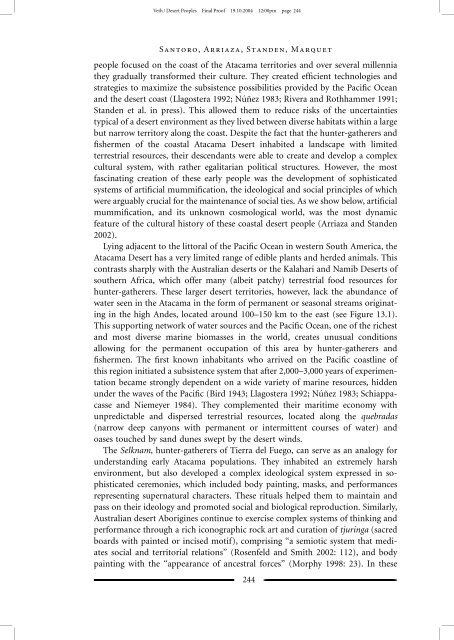Create successful ePaper yourself
Turn your PDF publications into a flip-book with our unique Google optimized e-Paper software.
Veth / <strong>Desert</strong> <strong>People</strong>s Final Pro<strong>of</strong> 19.10.2004 12:00pm page 244Santoro,Arriaza,Standen,Marquetpeople focused on <strong>the</strong> coast <strong>of</strong> <strong>the</strong> <strong>Atacama</strong> territories and over several millennia<strong>the</strong>y gradually transformed <strong>the</strong>ir culture. They created efficient technologies andstrategies to maximize <strong>the</strong> subsistence possibilities provided by <strong>the</strong> Pacific Oceanand <strong>the</strong> desert coast (Llagostera 1992; Núñez 1983; Rivera and Rothhammer 1991;Standen et al. in press). This allowed <strong>the</strong>m to reduce risks <strong>of</strong> <strong>the</strong> uncertaintiestypical <strong>of</strong> a desert environment as <strong>the</strong>y lived between diverse habitats within a largebut narrow territory along <strong>the</strong> coast. Despite <strong>the</strong> fact that <strong>the</strong> hunter-ga<strong>the</strong>rers andfishermen <strong>of</strong> <strong>the</strong> coastal <strong>Atacama</strong> <strong>Desert</strong> inhabited a landscape with limitedterrestrial resources, <strong>the</strong>ir descendants were able to create and develop a complexcultural system, with ra<strong>the</strong>r egalitarian political structures. However, <strong>the</strong> mostfascinating creation <strong>of</strong> <strong>the</strong>se early people was <strong>the</strong> development <strong>of</strong> sophisticatedsystems <strong>of</strong> artificial mummification, <strong>the</strong> ideological and social principles <strong>of</strong> whichwere arguably crucial for <strong>the</strong> maintenance <strong>of</strong> social ties. As we show below, artificialmummification, and its unknown cosmological world, was <strong>the</strong> most dynamicfeature <strong>of</strong> <strong>the</strong> cultural history <strong>of</strong> <strong>the</strong>se coastal desert people (Arriaza and Standen2002).Lying adjacent to <strong>the</strong> littoral <strong>of</strong> <strong>the</strong> Pacific Ocean in western South America, <strong>the</strong><strong>Atacama</strong> <strong>Desert</strong> has a very limited range <strong>of</strong> edible plants and herded animals. Thiscontrasts sharply with <strong>the</strong> Australian deserts or <strong>the</strong> Kalahari and Namib <strong>Desert</strong>s <strong>of</strong>sou<strong>the</strong>rn Africa, which <strong>of</strong>fer many (albeit patchy) terrestrial food resources forhunter-ga<strong>the</strong>rers. These larger desert territories, however, lack <strong>the</strong> abundance <strong>of</strong>water seen in <strong>the</strong> <strong>Atacama</strong> in <strong>the</strong> form <strong>of</strong> permanent or seasonal streams originatingin <strong>the</strong> high Andes, located around 100–150 km to <strong>the</strong> east (see Figure 13.1).This supporting network <strong>of</strong> water sources and <strong>the</strong> Pacific Ocean, one <strong>of</strong> <strong>the</strong> richestand most diverse marine biomasses in <strong>the</strong> world, creates unusual conditionsallowing for <strong>the</strong> permanent occupation <strong>of</strong> this area by hunter-ga<strong>the</strong>rers andfishermen. The first known inhabitants who arrived on <strong>the</strong> Pacific coastline <strong>of</strong>this region initiated a subsistence system that after 2,000–3,000 years <strong>of</strong> experimentationbecame strongly dependent on a wide variety <strong>of</strong> marine resources, hiddenunder <strong>the</strong> waves <strong>of</strong> <strong>the</strong> Pacific (Bird 1943; Llagostera 1992; Núñez 1983; Schiappacasseand Niemeyer 1984). They complemented <strong>the</strong>ir maritime economy withunpredictable and dispersed terrestrial resources, located along <strong>the</strong> quebradas(narrow deep canyons with permanent or intermittent courses <strong>of</strong> water) andoases touched by sand dunes swept by <strong>the</strong> desert winds.The Selknam, hunter-ga<strong>the</strong>rers <strong>of</strong> Tierra del Fuego, can serve as an analogy forunderstanding early <strong>Atacama</strong> populations. They inhabited an extremely harshenvironment, but also developed a complex ideological system expressed in sophisticatedceremonies, which included body painting, masks, and performancesrepresenting supernatural characters. These rituals helped <strong>the</strong>m to maintain andpass on <strong>the</strong>ir ideology and promoted social and biological reproduction. Similarly,Australian desert Aborigines continue to exercise complex systems <strong>of</strong> thinking andperformance through a rich iconographic rock art and curation <strong>of</strong> tjuringa (sacredboards with painted or incised motif), comprising ‘‘a semiotic system that mediatessocial and territorial relations’’ (Rosenfeld and Smith 2002: 112), and bodypainting with <strong>the</strong> ‘‘appearance <strong>of</strong> ancestral forces’’ (Morphy 1998: 23). In <strong>the</strong>se_ 244_
















